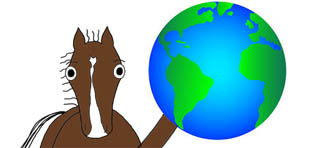 Saudiaramcoworld.com - Full Article
Saudiaramcoworld.com - Full Articleby Peter Harrigan
photo courtesy of the Saudi Commission for Tourism and Antiquities
When Mutlaq ibn Gublan decided to dig a birka (pond) to keep his camels watered, he arranged for a backhoe and drums of diesel fuel to be driven from the road to the site on his ancestral grazing lands in southwest Saudi Arabia. The spot he had chosen, amid finger-like valleys that cut through low sandstone hills, was near traces of an ancient waterfall, which hinted that, in millennia past, nature itself supplied more than a mere birka.
His pond was never completed. As he supervised the excavation, he says, "I spotted a smooth, shaped stone sticking out of the ground. I recognized it was an old and important object." He could tell at once it was a statue of an animal. It was buried upright, head toward the surface, he says. "I paid off the operator and told him to follow his tracks back to the road."
Over the next few years, Ibn Gublan unearthed some 300 objects there. Though none was as large as the first, his finds included a small stone menagerie: ostrich, sheep and goats; what may be fish and birds; a cow-like bovid (Bovidae); and an elegant canine profile that resembles one of the oldest known domesticated breeds, the desert saluki. In addition, he found mortars and pestles, grain grinders, a soapstone pot ornamented with looping and hatched geometric motifs, weights likely used in weaving and stone tools that may have been used in leather processing, as well as scrapers, arrowheads and blades—including an exquisitely decorated stone knife in the unmistakable curved design of the traditional Arabian dagger.
Two years ago, he loaded it all up in his Jeep, drove it to Riyadh and donated it to the Saudi Commission for Tourism and Antiquities (scta).
"When I first saw the pieces, I just could not believe it. It was, how can I say, incroyable," recalls Ali al-Ghabban, head of antiquities at the scta, his French-accented English giving away his years at the University of Provence. "This is Neolithic material," he states, from "a sophisticated society possessing a high level of art and craftsmanship that we have not previously seen." Al-Ghabban had a laboratory run a radiocarbon analysis on trace organic remains found later alongside some of the objects. That dated the material to between 6590 and 7250 bce, he says...
Read more here:
http://www.saudiaramcoworld.com/issue/201203/discovery.at.al-magar.htm


